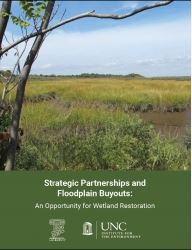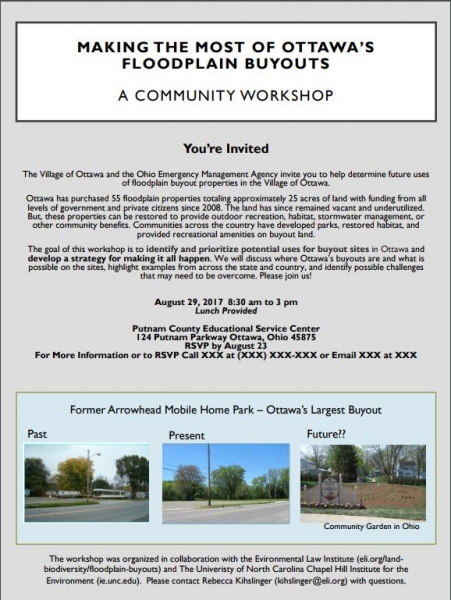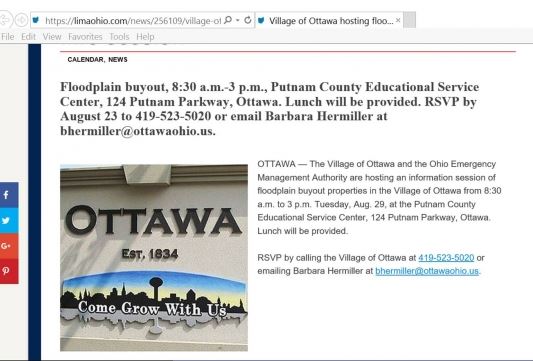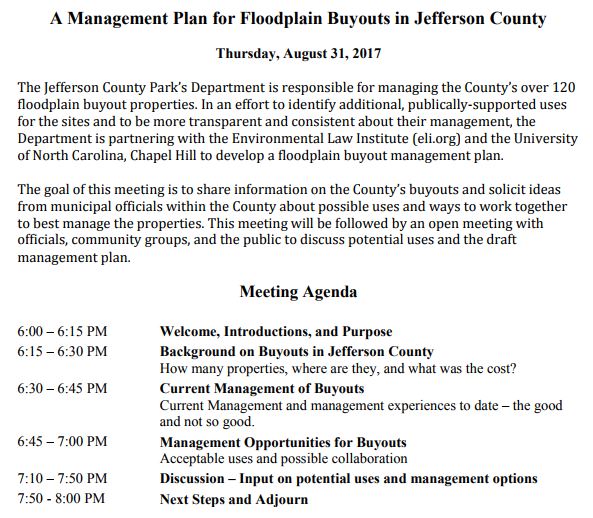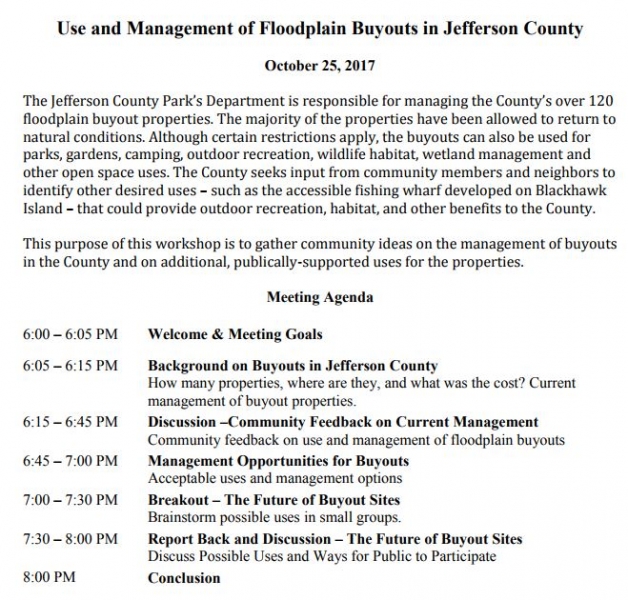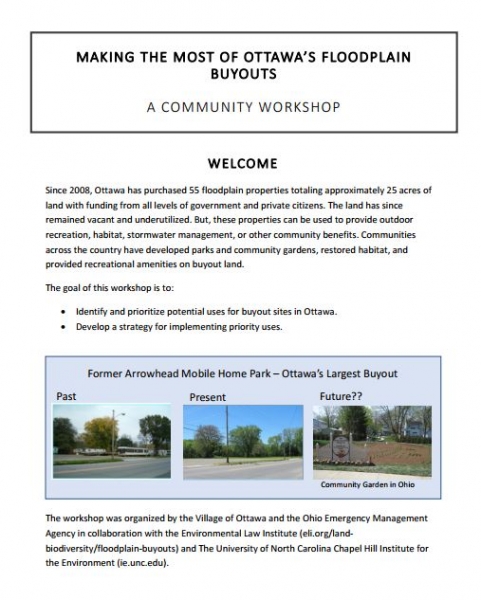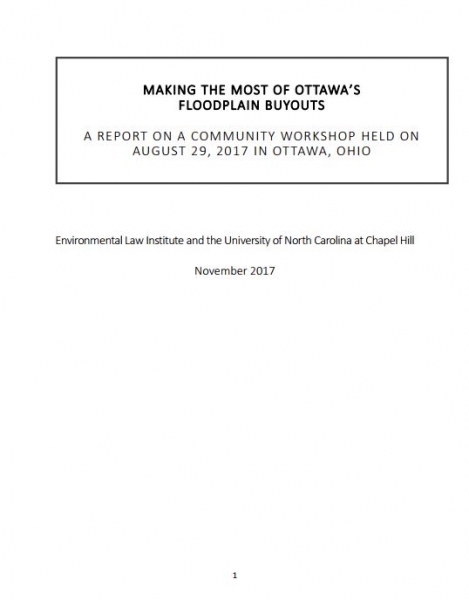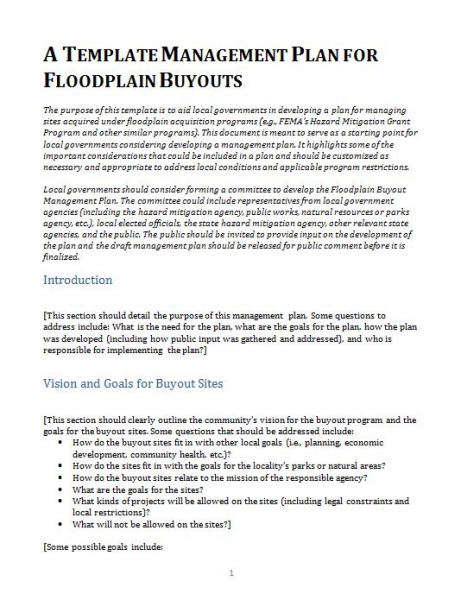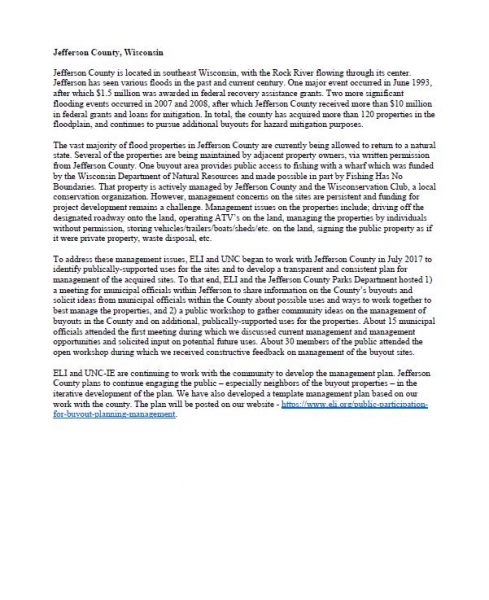Floodplain acquisitions allow local governments to move people out of harm’s way and reduce the risk of future structural damage and associated disaster recovery costs in the flood-prone area. Once properties are acquired and structures are removed, communities can also benefit by converting acquired land to parks and other community amenities or restoring ecosystems for water quality, flood resilience, and habitat benefits. Well-planned opportunities for public participation in the planning, implementation, and maintenance or management of post-acquisition projects on floodplain buyout properties can strengthen the project, secure community buy-in, and lead to strategic partnerships that can improve long-term success. A well-planned process will instill a sense of accountability between the local government agency managing the buyout sites and the community based on a common understanding of feasibility and context.
We developed a five-step outline for organizing public participation in the floodplain buyout process based on research and our experiences with pilot projects in Iowa, Ohio, and Wisconsin. The steps in this guide will help local governments solicit community feedback on post-acquisition management projects. Recognizing that different communities may be at different stages of the floodplain acquisition process, however, the steps can be carried out at different points in the floodplain buyout process: in preparation of hazard mitigation funding becoming available (e.g., proactively to ensure the community can be strategic about how to target mitigation funding); while acquisition programs are being carried out (when community interest may be highest); or after a buyout that leaves space available for projects compatible with allowable uses (sometimes this occurs may years after the buyout).
It is important to note that some municipalities may have rules or specific procedures for public participation in planning the types of projects that may be compatible with floodplain buyouts, and these will need to addressed. Additionally, some buyout planners may choose to repeat certain steps such as meetings and incorporating community input in order to ensure that priorities and wants were interpreted correctly.
[accordion]
 1. GATHER INFORMATION & SET SCOPE: Conduct preliminary research and get to know the context of the potential buyout project.
1. GATHER INFORMATION & SET SCOPE: Conduct preliminary research and get to know the context of the potential buyout project.
Understanding the context of a potential buyout project is vital for developing priorities, managing expectations, and productively involving the public to participate. Good information is key for good planning. Important contextual information includes landscape features of the buyout site, cultural resources and features, surrounding land uses, deed restrictions attached to the site, funding opportunities, local capacity, relevant rules and regulations, and information on exisitng and planned community amernities. It is possible that strategic partnerships may reveal additional opportunities, especially when additional resources and capacity can be leveraged through partnership. To learn more about where to find this information, visit our Action Guide and see the section titled “Making Informed Decision and Taking Action” at p 37.
Three key categories of information that are important at this phase are the geographic distribution of relevant features, relevant rules and regulations, and the availability or eligibility of financial resources. Here are some suggestions for gathering this information:
MAPS: Maps are useful tools for visualizing and analyzing various factors that make up the context of a buyout project. Maps developed early in the planning phase should include information on the following topics:
- Location of Buyouts: showing the location of buyout parcels, if possible
- Landscape Features: including wetlands, wildlife habitat, potential restoration sites, and flood zones
- Infrastructure: existing and planned infrastructure
- Amenities & public facilities: existing and planned recreational, cultural, and natural amenities or facilities
Resources: Maps from Ottawa, Ohio, and Cherokee, Iowa (coming soon). See more information in our Planning & Prioritization Guide coming soon
PLANS and LOCAL REGULATIONS: Existing plans and regulations that may influence a potential buyout project should be reviewed. The legal and political landscape can reveal opportunities for projects, but also affects the feasibility of some projects. Relevant plans include those addressing natural and cultural preservation priorities, parks and recreation, land use, and economic development. There may be relevant regulations addressing public participation in certain projects, land use and zoning, development or work near wetland, and soil or water quality. Further, where a community anticipates that additional acquisitions will occur in the future, strategic prioritization of such buyouts can allow a community to target limited resources to areas that will maximize post-acquisition opportunities for habitat value and connectivity, fulfilling community objectives, and supporting community resilience.
Resource: Our Planning & Prioritization is coming soon!
FINANCIAL RESOURCES: Finally, considering the availability of financial resources (including in-kind donations) may help set goals for the buyout project and set a scope for the range of possible projects.
Resource: Our Financing & Incentives guide is coming soon!
 2. MAKE A PLAN FOR OUTREACH: Create a plan for community outreach and develop opportunities for public input.
2. MAKE A PLAN FOR OUTREACH: Create a plan for community outreach and develop opportunities for public input.
The first step is to define goals for the outreach effort. For example, goals for the post-acquisition outreach effort may be to: 1) inform community members of your intent to conduct a project (or projects) or create a management plan for buyouts, 2) gather input on community needs and desired outcomes as well as on proposed projects or management plans, and 3) build buy-in for the implementation and maintenance phases of the project. Other goals may be appropriate or relevant for your community, but it is important to be clear about what you are trying to accomplish with the outreach before moving forward.
Once goals have been identified, the next step is to create a list of target audiences for outreach. This list will help a community design outreach approaches. Target audiences may include community officials, conservation professionals (including representatives from state agencies, local non-profits, etc.), and community interest groups- but most importantly, neighbors and community members in the vicinity of the potential buyouts. Develop a list of existing networks and points of contacts that can help reach these target audiences, and make note of gaps in information for reaching certain stakeholder groups. This part of the outreach planning process should also include identifying potential funders for post-acquisition projects who may be interested in being involved early on or have the potential to offer opportunities for post-acquisition projects that may not otherwise have been feasible.
Once you know who you want to reach, you can plan how to reach them. Consider which combination of outreach methods (i.e., phone surveys, social media campaigns, canvassing, workshops, etc.) will reach the audience of diverse community members from which you may be seeking input from. Various platforms for outreach have certain audiences, purposes, and pros & cons. Potential platforms include: internet and social media, phone calls, posting flyers, making announcements via local radio or television, etc. See EPA's "Getting In Step" Guide at pp 98-114 for further guidance on these various means and methods.
An important part of this outreach effort will be to gather input from community members. Thus, the outreach plan should include planning (including how to solicit participation) and hosting an event or other opportunity for gathering input on the buyout and management planning processes. Events can be a good way to gather community members for input. Meeting in person provides the opportunity to develop consensus on goals, brainstorm, bring various stakeholders together, and answer questions and concerns. Keep this in mind as you develop opportunities for public input (more information on events below).
 3. CONDUCT OUTREACH & HOST EVENT: Conduct outreach and collect input, providing an opportunity for meaningful participation.
3. CONDUCT OUTREACH & HOST EVENT: Conduct outreach and collect input, providing an opportunity for meaningful participation.
OUTREACH. As discussed in step 2, outreach includes providing information and setting expectations for the public about the community's plan for management and use of acquired floodplain properties as well as providing opportunities for the community to provide input on potential projects and management choices. This process gives communities the chance to reflect on goals and desired outcomes of a project.
Your outreach plan should already detail the selected methods and platforms that will most effectively reach the identified targeted audiences with information on the community's plans for the buyout lands. In this outreach step, you should develop and distribute relevant materials. Some types of materials that may be useful include: fact sheets, maps, FAQs (i.e., frequently asked quesitons), radio ads, media interviews, etc. The materials should clearly and concisely explain the buyout process, project opportunities and regulatory (and other) restrictions on buyout sites, the community's plan for managing the sites and engaging the community in their use and mangement. Consider translating the materials, if necessary and appropriate. Materials could be distributed via mail, email, social media, posting to the community's website, or newspaper or radio advertisement,
The outreach plan will also include plans for events or other methods for gathering input. Events could include meetings, workshops, or other community events. You may also choose to gather input at existing venues for public participation such as meetings for or hosted by a parks board, city council, or other municipal entity relevant to community planning and land use decisions (including those relevant to funding). Surveys (via phone, internet, mail) can also be a way to get input for certain audiences.
Resource: See an example announcement flyer for a workshop in Ottawa, Ohio, and an announcement (which could be posted online or in a newspaper) for the same event.
EVENT. Events are an importnat way to gather community input. Invitations for the event (e.g., workshop, meeting) should be distributed with sufficient notice, generally about one month ahead of the event. The invitation and any other materials, which may be in the form of flyers, postcards, posters, or other, should be distributed broadly and include a point of contact for questions and suggestions leading up to the event. As above, invitations could be distributed via mail, email, social media, posting to the community's website or calendar, or newspaper or radio advertisement, You should also include specific goals for the event so that participants have appropriate expectations for outcomes. Goals and desired outcomes for the event should be articulated early on and based on previous contextual research and the scope set by organizers.
Consider the pros and cons of different event formats, venues, and potential co-hosts. Some key factors are convenience (timing and location), accessibility, and the availability of alternatives for participation if attendance is infeasible – all for the targeted participants determined in the planning phase. The venue should be tailored to expected attendance levels if possible.
For most meetings, an agenda shoud be developed and distributed with the event invitation. The agenda should clearly lay out the goals for the meeting and the timeline for the event. Stick to the agenda as closely as possible. You may also wish to develop materials to hand out to event participants. Materials may include a map, agenda, other images or visuals, other information that may help participants provide the most effective input (e.g., any restrictions on the the type of projects that can occur on buyout properties).
The event should be dynamic and involve attendees to maximize opportunities for input. Some ways to structure a meeting to maximize input include planning hands-on activities (e.g., allowing participants to brainstorm and sketch designs, on maps), including time for small group discussions, or conducting polling on various ideas. Another way to engage event participants may be to organize a site walk-through as part of the event. This can help community members visualize potential projects and provides a shared experience for participants to refer back to during future conversations. It may also be useful to have a designated note-taker in order to keep accurate records of ideas and feedback from participants.
Finally, you should collect attendees’ contact information for follow-up communications. If you choose to produce a workshop report, the document should at least be sent to participants. Such a report may help start defining exactly which ideas, goals, or concerns will be incorporated into a project or management plan.
Resources: Check out this example meeting agenda for municipal officials and an example community meeting agenda. Here is an example of workshop materials.
 4. SYNTHESIZE & INCORPORATE COMMUNITY INPUT: Analyze and incorporate the results from community outreach and the community event into plans for the buyout project.
4. SYNTHESIZE & INCORPORATE COMMUNITY INPUT: Analyze and incorporate the results from community outreach and the community event into plans for the buyout project.
After the event and other solicited community input, develop a brief report of the findings that illustrates potential management and use opportunities for the buyout site and illustrates potential funding sources for implementation. Make the report available to the public.
The findings should then be incorporated into a buyout project plan or program management plan. At this point, you may also wish to go back to the community for further input on the draft plan. For project plans, this may be another opportunity for site visits to visualize any proposed projects in context and identify any challenges. Relevant agencies and entities – including the state hazard mitigation grant officer – should also be invited to review the plan for accuracy and feasibility.
Resource: See this example workshop report from Ottawa, Ohio.
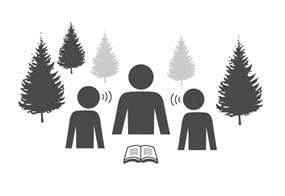 5. COMMUNICATE OUTCOMES: Provide continued updates and useful communication to community.
5. COMMUNICATE OUTCOMES: Provide continued updates and useful communication to community.
The final proposal or plan, including applicable input from the community, should be distributed to the public and interested stakeholders. The plan may include other ways to involve community members in the project implementation and monitoring phases of possible post-buyout projects. This step of the public participation process is ongoing – public participation efforts, community satisfaction, and overall project effectiveness should be measured and evaluated. Promoting successes and acknowledging challenges and opportunities throughout the rest of the project can help maintain community buy-in and participation.
Resource: See here for an example management plan.
[/accordion]
Reference and Example Materials for Facilitating Public Participation
Gathering Information & Setting Scope
|
|
|
|
Outreach & Hosting an Event
|
|
|
Municipal Officials Meeting Agenda
|
|
|
Synthesizing Community Input
|
|
Communicating Outcomes
|
|
Pilot Community Case Studies
|
|
Cherokee, IA [Coming Soon!] |
Ottawa, OH [Coming Soon!] |


